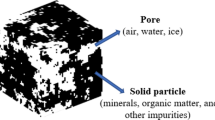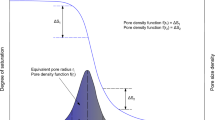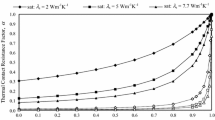Abstract
An enhanced series-parallel (S-II) model of one-dimensional conductive heat flow through a unit cell was developed to estimate the time-dependent thermal conductivity of Class C fly ash stabilized soils. The unit cell is composed of three separate heat flow paths: a continuous path through solid contacts (soil contacts, fly ash contacts, and soil fly ash contacts) in parallel arrangement, a series-parallel path of solids in a series arrangement with a parallel arranged path of solid-miniscule pores (miniscule portion of solid water and miniscule portion of solid air), and a continuous path through water and air in parallel arrangement. The solid-miniscule pores volume fraction and the fluid/air volume fraction changes during pozzolanic reaction were modeled by estimating the interparticle pore water consumption rate. In addition, the time-dependent thermal conductivity characteristics of the fly ash soil mixtures were investigated by conducting experimental tests. Based on the test observations and parametric analysis, interparticle voids, fly ash percentage and degree of cementation, volume change of the interparticle liquids, and curing time were all found to play critical roles on the effective thermal conductivity of fly ash soil mixtures. The predicted thermal conductivity using the enhanced S-II model was compared with the experimental test data with good agreement, suggesting that the enhanced S-II model is a robust tool for estimating the global effective thermal conductivity of Class C fly ash stabilized soils.



















Similar content being viewed by others
Abbreviations
- \(\lambda _s\) :
-
Thermal conductivity of dry solid
- \(\lambda _w\) :
-
Thermal conductivity of water
- \(\lambda _a\) :
-
Thermal conductivity of air
- \(\lambda _f\) :
-
Thermal conductivity of fluid
- \(\Theta _{\mathrm{sb}}\) :
-
A continuous path through solid contacts
- \(\Theta _w\) :
-
A continuous path through water
- \(\Theta _\mathrm{f}\) :
-
A continuous path through fluid
- \(\Theta _\mathrm{a}\) :
-
A continuous path through air
- \(\hbox {n}_{\mathrm{wm}}\) :
-
A series-parallel path of solids in a series arrangement with a parallel arranged path of solid particles-miniscule pores filled with air/water
- n :
-
Soil porosity
- \(\varepsilon \) :
-
Interparticle air–water interfacial coefficient
- R :
-
Universal gas constant (8.3144 J/mol K)
- \(\omega _0\) :
-
Initial water content
- \(\omega _f\) :
-
Final water content
- T :
-
Temperature of the fly ash/fly ash soil mixture
- \(T_0\) :
-
The peak temperature of fly ash/fly ash soil mixture
- t :
-
Time
- \(t_0\) :
-
Time corresponding to the peak temperature of fly ash/fly ash soil mixture
- a :
-
The slope of the temperature drop
- b :
-
The temperature difference between the final temperature and the peak temperature at a given time
- k :
-
The pozzolanic reaction rate
- A:
-
Gas constant \((t^{-1})\)
- \(E_a\) :
-
Apparent activation energy (J/mol), the \(E_a\) of fly ash in this study is 12.5 J/mol
- \(T_{set}, T_{set}=\ln \left( {\frac{t}{t_0}} \right) \) :
-
The natural logarithmic of time over the time \(t_0 \)
- \(S\left( {T_{set}} \right) \) :
-
The summary of the speed from time 0 to infinity (28 days of curing)
- \(\gamma \) :
-
The Euler gamma constant (\(\gamma \approx 0.577\))
- \(G_s\) :
-
Specific gravity of soil
- \(e_0\) :
-
Initial void ratio
- Q:
-
The power per unit length (W m\(^{-1}\))
- \(\lambda \) :
-
The thermal conductivity of the sample (W m\(^{-1}\,\mathrm{K}^{-1}\))
- \(a^{\prime }\) :
-
The thermal diffusivity (m\(^{2}\,\mathrm{s}^{-1}\))
- r :
-
Radius of the measured temperature range
References
Abu-Hamdeh, N.H., Reeder, R.C.: Soil thermal conductivity: effects of density, moisture, salt concentration, and organic matter. Soil Sci. Soc. Am. J. 64, 1285–1290 (2000)
Abuel-Naga, H.M., Bergado, D.T., Bouazza, A.: Thermal conductivity evolution of saturated clay under consolidation process. Int. J. Geomech. 8(2), 114–122 (2008)
ASTM D 698, Standard Test Methods for Laboratory Compaction Characteristics of Soil Using Standard Effort (12 400 ft-lbf/ft3 (600 kN-m/m3))
Campbell, G.S.: Soil Physics with BASIC: Transport Models for Soil–Plant Systems. Elsevier Science Publishing Co., New York (1985)
Cote, J., Konrad, J.M.: Assessment of structure effects on the thermal conductivity of two-phase porous Geomaterials. Int. J. Heat Mass Transf. 52, 796–804 (2009)
de Vries, D.: Thermal properties of solids. In: Van Wijk, W.R. (ed.) Physics of the Plant Environment, pp. 210–235. Wiley, New York (1963)
Edil, B.T., Hector, A.A., Benson, C.H.: Stabilizing Soft Fine-Grained Soils with Fly Ash. J. Mater. Civ. Eng. 18, 283–294 (2006)
Gori, F.: A theoretical model for predicting the effective thermal conductivity of unsaturated frozen soils. In: Proceedings of the Fourth International Conference on Permafrost, Fairbanks (Alaska). pp. 363–368. National Academy Press, Washington, D.C. (1983)
Horpibulsuk, S., Rachan, R., Raksachon, Y.: Role of fly ash on strength and microstructure development in blended cement stabilized silty clay. Soils Found. 49(1), 85–98 (2009)
Hotz, R.D., Ge, L.: Investigation of the thermal conductivity of compacted silts and its correlation to the elastic modulus. J. Mater. Civil Eng. 22(4), 408–412 (2010)
Kang, X., Kang, G., Ge, L.: Modified time of setting test for fly ash paste and fly ash-soil mixtures. J. Mater. Civil Eng. 25(2), 296–301 (2013)
Kang, X., Kang, G-C., Chang, T-K., Louis, Ge: Chemically Stabilized Soft Clays for Road Base Construction. J. Mater. Civil Eng., ASCE. doi:10.1061/(ASCE)MT.1943-5533.0001156. (2014)
Kang, X., Ge, L., Kang, G.-C., Mathews, C.: Laboratory investigation on the strength, stiffness, and, thermal conductivity of fly ash and lime kiln dust stabilized clay subgrade materials. Road Mater. Pavement Des. (2015a). doi:10.1080/14680629.2015.1028970
Kang, X., Ge, L., Liao, W.-C.: Cement hydration based micromechanics modeling of the time-dependent small-strain stiffness of fly ash stabilized soils. Int. J. Geomechan. ASCE. (2015b). doi:10.1061/(ASCE)GM.1943-5622.0000552
Lee, J.K., Shang, J.Q.: Evolution of thermal and mechanical properties of mine tailings and fly ash mixtures during curing period. Can. Geotech. J. 51, 570–582 (2014)
Lu, S., Ren, T., Gong, Y., Horton, R.: An improved model for predicting soil thermal conductivity from water content at room temperature. Soil Sci. Soc. Am. J. 71(1), 8–14 (2007)
Ochsner, T.E., Horton, R., Ren, T.: A new perspective on soil thermal properties. Soil Sci. Soc. Am. J. 65, 1641–1647 (2001)
Santamarina, J.C., Klein, K.A., Fam, M.A.: Soils and Waves-Particulate Materials Behavior, Characterization and Process Monitoring. Wiley, New York (2001)
Shon, C-H., Saylak, D., Mishra, S. K.: Combined use of calcium chloride and fly ash in road base stabilization Transportation Research Record, No. 2186, pp. 120-129 (2010)
Tarnawski, V.R., Momose, T., Leong, W.H., Bovesecchi, G., Coppa, P.: Thermal conductivity of standard sands, Part I. dry-state conditions. Int. J. Thermophys. 30(3), 949–968 (2009)
Tarnawski, V.R., Leong, W.H.: A series-parallel model for estimating the thermal conductivity of unsaturated soils. Int. J. Thermophys. 33(7), 1191–1218 (2012)
Tarnawski, V.R., Gori, F., Wagner, B., Buchan, G.D.: Modeling approaches to predicting thermal conductivity of soils at high temperatures. Int. J. Energy Res. 24, 403–423 (2000)
Woodside, W., Hessmer, J.H.: Thermal conductivity of porous media. I. Unconsolidated sands. J. Appl. Phys. 32(9), 1688–1699 (1961)
Yun, T.S., Santamarina, J.C.: Fundamental study of thermal conduction in dry soils. Granular Matter 10(3), 197–207 (2008)
Author information
Authors and Affiliations
Corresponding author
Rights and permissions
About this article
Cite this article
Kang, X., Ge, L. Enhanced series-parallel model for estimating the time-dependent thermal conductivity of fly ash soil mixtures. Granular Matter 17, 579–592 (2015). https://doi.org/10.1007/s10035-015-0577-x
Received:
Published:
Issue Date:
DOI: https://doi.org/10.1007/s10035-015-0577-x




